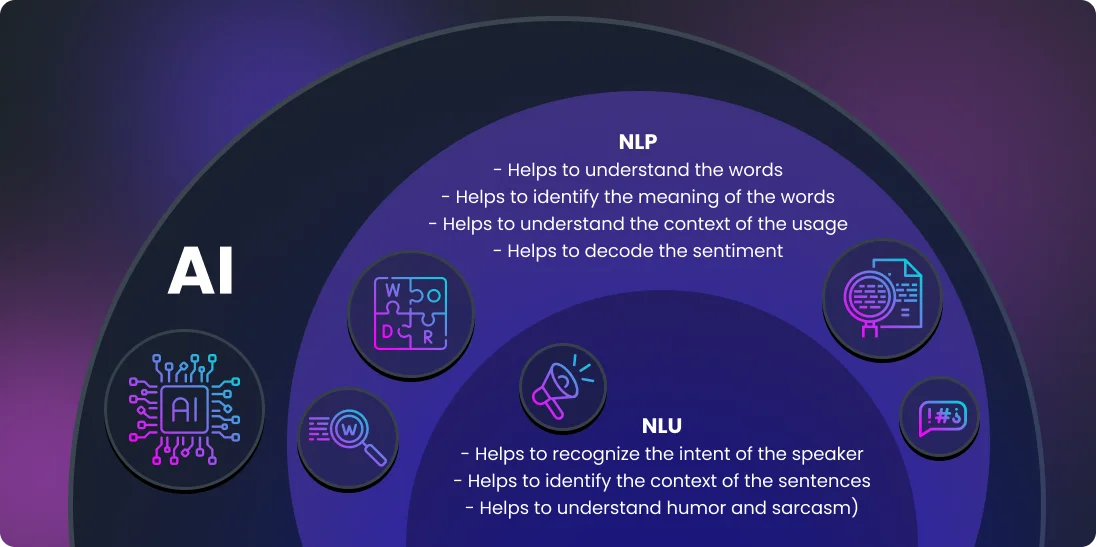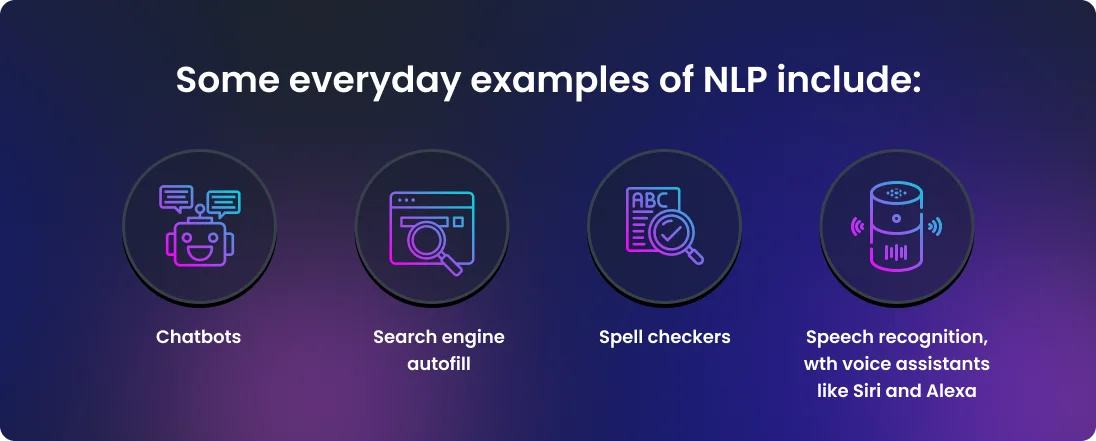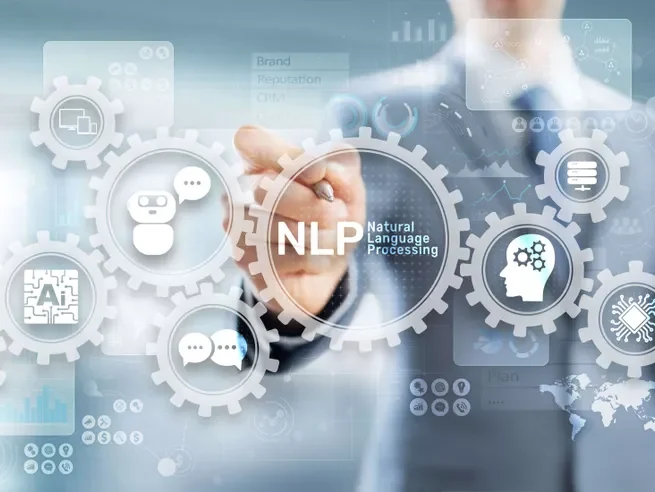Imagine asking a voice assistant to play your favorite song or chatting with a customer service bot that seamlessly addresses your queries. How do these technologies understand and respond to human language so effectively? This is nothing else but the result of innovative technologies known as Natural Language Processing (NLP) and Natural Language Understanding (NLU).
These instruments enable computers to understand text, serving as the intelligence that powers sophisticated AI chatbots. In this article, we’ll clarify these tech concepts. We’ll explain what is NLU and NLP, what is the difference between NLP and NLU, and illustrate how they’re applied in the business. So, if you are looking for new technologies that will help to gain an advantage in the competitive business environment, then we want to show how these complex concepts work.
Understanding NLP
Natural Language Processing is a subset of Artificial Intelligence that empowers machines to comprehend and extract significance from human language. Here the realms of computer science, AI, and linguistics collaboratively work to enhance a computer’s understanding of human language.
NLP operates on several levels:
- understanding words (syntax)
- identifying the meaning of those words (semantics)
- apprehension of the context in which those words are used (pragmatics)
- decoding the tone or sentiment behind those words (sentiment analysis)
Examples of NLP are numerous in our everyday routine. For example, when smartphones autocorrect the mistakes in the text, they use these technologies to understand your writing and even correct spelling or grammar. Your interactions with Siri or Google Assistant are facilitated by natural language processing, enabling these systems to respond to verbal commands.
From a business perspective the cases of usage of NLP are vast. Companies apply them to analyze customer sentiment from social media or reviews. It helps to tailor business services or products based on customer feedback. In the financial sector, natural language processing assists to interpret complex legal documents. Similarly, in healthcare, NLP is applied to evaluate patient records and predict health trends, enhancing patient care.
The core distinction between NLU vs NLP lies in the machine’s depth of comprehension of human language. If you want a deeper understanding of the new technology, read our more detailed article devoted to NLP. There, we concentrate solely on natural language processing and tell more about the inside-out information of the innovative methodology.
Understanding NLU
Natural Language Understanding, a part of NLP, makes computers better catch human language. It helps computers grasp not just the words, but also the meaning behind them. It teaches to understand the full meaning of sentences, including any emotions or cultural hints.
NLU’s main job is to help understand human language better. It tries to make them catch things like sarcasm and humor, which they usually miss.
Examples of NLU in use are becoming more commonplace, particularly in AI-powered chatbots. For instance, if you were to tell a chatbot, “I need a pizza without pineapples,” a simple NLP system might interpret the message as you needing a pizza and pineapples. In contrast, an NLU-powered chatbot would comprehend that you’re asking for a pizza without pineapples.
In a business setting, NLU can potentially transform customer service. An AI customer service agent powered by NLU understands and responds more intuitively to customer complaints, requests, or feedback. We have already displayed how beneficial the NLP is for the different business spheres. Check some of our thoughts about the NLP examples in business.

NLU vs NLP: Main differences
Now to address the central question: “What is the difference between natural language processing vs natural language understanding?”. At first glance, the terms have minor distinctions because they involve machines interacting with human language. These distinctions become apparent once we study their functionalities.
The key aim of NLP and NLU is to teach machines to understand languages. NLP is the broader field, handling tasks like reading, understanding, and responding to speech. NLU, on the other hand, is a segment of NLP, but it dives deeper. It not only understands the language, but it also interprets the context and intent behind the words.
Think of NLP as a tool for reading and analyzing human language and NLU as the intelligent sibling that goes a step further. NLU utilizes the insights derived from NLP to uniquely comprehend the true essence of language, including the ability to discern nuances such as humor or sarcasm within a statement.
If we compare NLU vs NLP, in such case, Natural Language Processing is like a language translator. It can accurately translate a sentence from one language to another, but may miss the cultural context. Natural Language Understanding, in contrast, is like a local guide — it translates and provides a more culturally accurate translation.
Despite their distinctions, NLP and NLU complement each other with their unique strengths and capabilities. One or both might be used depending on the need – whether it’s a simple language task or a complex understanding of context.
NLP is a jack of all trades — it’s used everywhere, from spell checkers to voice recognition. Any task that requires a basic understanding of language falls under its reign. NLU, however, is the master of one — it shines when a deep understanding of language is needed, like understanding jokes in social media or handling complex customer queries.
Though NLU vs NLP differentiate in their roles and capabilities, they work together like two peas in a pod. They’re the dynamic duo that powers AI systems, making them more interactive and intelligent. Such teamwork improves machine-human interactions and how businesses operate and interact with customers.
Business use cases for NLP and NLU
The practical implementations of NLP and NLU in the business world are vast and varied. Companies in various sectors leverage these technologies to drive innovation, improve customer interactions, and streamline operations.
Customer service is among the most common areas to use NLP and NLU. AI chatbots efficiently handle consumer queries and complaints. These chatbots understand the user’s words and queries, leading to more empathetic and effective customer interaction.
Consider the case of the global e-commerce giant Amazon. Its virtual assistant, Alexa, leverages NLP and NLU to understand customer commands. Alexa uses NLP to process the user’s voice command and NLU to understand the context and intent of the knowledge, delivering a seamless user experience.
Similarly, companies like IBM use NLP in their AI platform, Watson, to extract valuable insights from unstructured data, helping businesses make data-driven decisions. Conversely, Google utilizes NLU in its search engine to better understand user queries and provide more accurate search results.

NLU vs NLP in the context of AI
The significance of both NLP and NLU lies in their ability to narrow the divide between human and machine communication, ultimately enhancing the intuitiveness of AI.
While NLP provides the framework for machines to interact with human language, NLU elevates this interaction by adding an understanding of context and intent. Both technologies have immense potential in business as it improves customer interactions and aids decision-making processes. Looking ahead, the NLP and NLU are combining with improvements in machine learning and deep learning. This means we’ll get more intelligent AI systems that understand and copy how humans talk and communicate.
The true power of NLP and NLU is to turn unstructured data into actionable insights. Companies that leverage these technologies effectively will undoubtedly have a competitive edge in the ever-evolving digital marketplace.
Start benefiting from the newest AI technologies right now
We have developed an AI-based chatbot to help businesses carry out their tasks. Its main purpose is to automate your business’s customer support. Imagine how just one chatbot can handle 87% of your customer’s inquiries in mere seconds.
If you are wondering how this is possible, then you can try the demo version of our chatbot for free. All you need is the link to your website — enter the link in the field on our platform and the test version of the bot, ready to answer the typical questions of your business, will surprise you. Try it now! All it takes is just a couple of minutes, but the benefits you get from MetaDialog will support your business 24/7, without any breaks or the need for pay raises.
